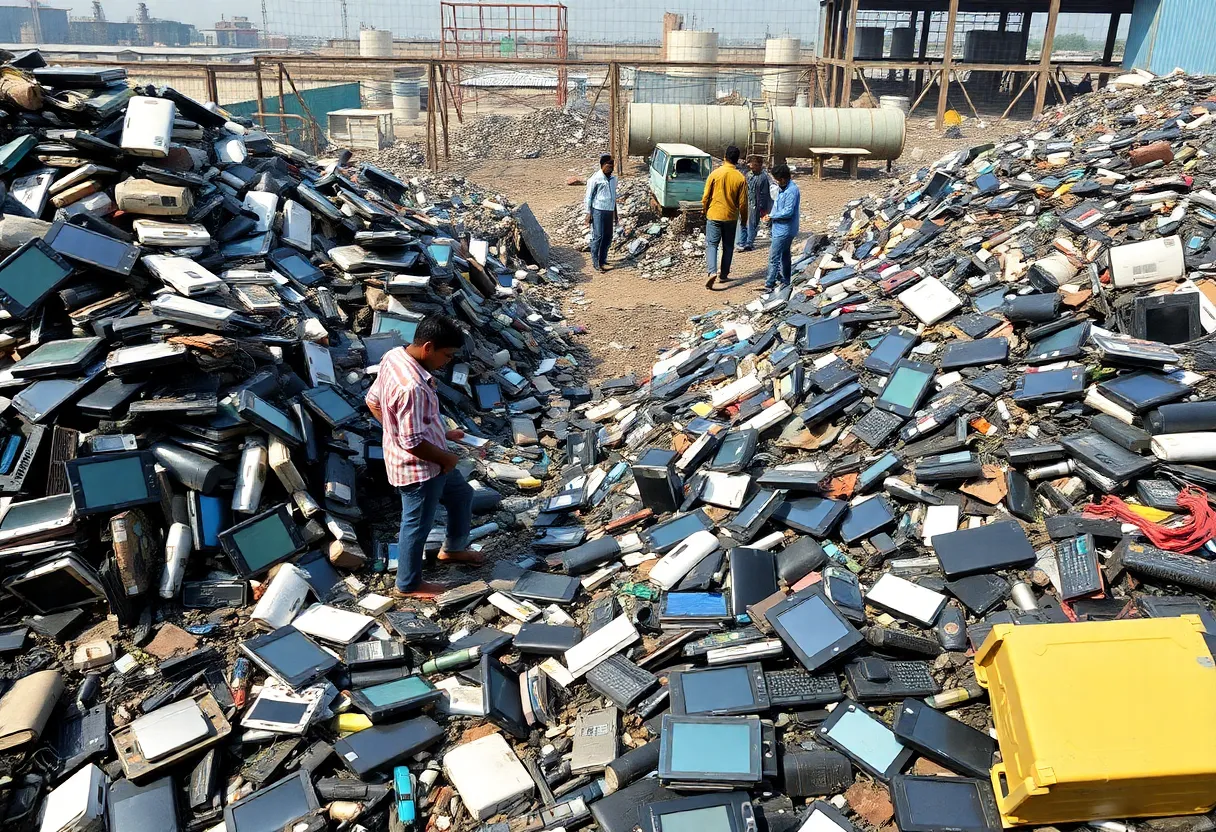News Summary
India is now the third-largest producer of e-waste globally, generating over 1.6 million tonnes in 2022. The Seelampur area in New Delhi is a hotspot for e-waste, where informal workers sift through hazardous materials for valuable recyclables. Innovative startups are emerging to tackle this issue, recycling lithium-ion batteries and boosting the market. However, workers face health risks and inadequate compensation. The Indian government aims for ambitious e-waste recycling goals, yet challenges remain. Effective waste management strategies are urgently needed to address the rising e-waste crisis.
India’s Growing E-Waste Challenge
India is facing a significant increase in the amount of e-waste it generates, having produced over 1.6 million tonnes in 2022 alone. This puts the country as the third-largest producer of e-waste in the world, just behind China and the United States. With more people purchasing electronic devices than ever before, the issue is only expected to grow in the coming years, making it crucial to address this environmental challenge.
The Heart of E-Waste: Seelampur, New Delhi
One of the hotspots for e-waste in India is the Seelampur area in New Delhi, which boasts the largest e-waste market in the country. Here, more than 50,000 informal workers sift through heaps of discarded electronics in search of valuable recyclable materials. Sadly, many of these laborers, including women and children, earn only about $6-7 a day, which is below the city’s minimum wage. This lack of fair compensation goes hand-in-hand with the absence of basic safety gear, leaving these workers vulnerable to hazardous waste.
What’s Inside Our E-Waste?
Electronic waste isn’t just junk; it harbors valuable materials like lithium, cobalt, nickel, copper, and aluminum, all essential for manufacturing new electronic devices and contributing to renewable energy technologies. The process these informal workers use to extract materials from discarded gadgets is aptly termed urban mining, a crucial method for enhancing the sustainability of our energy systems.
Innovative Start-Ups on the Rise
Amidst this dire situation, some bright sparks are emerging in the form of innovative start-ups like Metastable Materials. These companies are stepping into the e-waste arena, focusing on efficiently recycling lithium-ion batteries and recovering precious minerals. With projections indicating that the e-waste recycling market in India could balloon to $7.5 billion by 2030, the small battery recycling sector alone is expected to grow to $1 billion within the same period.
Recycling: The Environmental Champion
Recycling not only helps recover valuable materials but can significantly reduce the need for new mining operations. Estimates suggest a potential reduction of about 40% for copper and cobalt, and 25% for lithium and nickel by 2050. This could lead to a substantial decrease in greenhouse gas emissions—something everyone can get behind.
Government Goals and Challenges
The Indian government has rolled up its sleeves and set ambitious targets for e-waste recycling. They aim to achieve a 90% recovery rate of electric vehicle battery materials by 2027, along with ensuring that 20% of materials used in new batteries come from recycled sources by 2030. However, it’s important to note that despite these positive initiatives, many workers in the e-waste sector still lack the social protections and decent wages they desperately need.
Health Risks for Informal Workers
The informal processing methods utilized in e-waste recycling expose these workers to toxic fumes and heavy metals. This isn’t just a workplace hazard—it’s a threat to their health, increasing the risk of respiratory diseases and serious neurological disorders, especially in children who work in these environments.
Regulatory Efforts and Future Directions
To tackle these challenges, the Indian government is considering initiatives such as Extended Producer Responsibility (EPR), encouraging companies to take responsibility for the lifecycle of their products. Moreover, the Basel Convention aims to hold export nations accountable for e-waste management. Yet, it comes with loopholes that need addressing.
Formalizing the Informal Sector
There are rising calls for the formalization of the informal e-waste sector, emphasizing the importance of integrating workers into the supply chain. Providing these individuals with adequate support and protections is crucial, as they form the backbone of the current recycling system.
The Future: A Collective Responsibility
As we continue to grapple with the rising tide of e-waste, it is evident that global efforts must be galvanized to confront this growing crisis. With only around 20% of e-waste currently collected and recycled through formal channels, vast amounts are left to collect dust in landfills or be processed in unsafe environments. This issue is compounded by the increasing demand for both electronic devices and clean energy technologies, underscoring an urgent need for effective waste management strategies and policies.
Deeper Dive: News & Info About This Topic
- Climate Change News: Indian Start-Ups Mine E-Waste
- Wikipedia: E-waste
- Entrepreneur: India’s E-Waste Market
- Google Search: E-waste in India
- Deccan Herald: E-Waste Piles Up
- Google Scholar: E-waste Recycling
- DW: E-Waste from AI Computers
- Encyclopedia Britannica: E-waste
- Solar Quarter: India’s E-Waste Management Rules
- Google News: India e-waste







